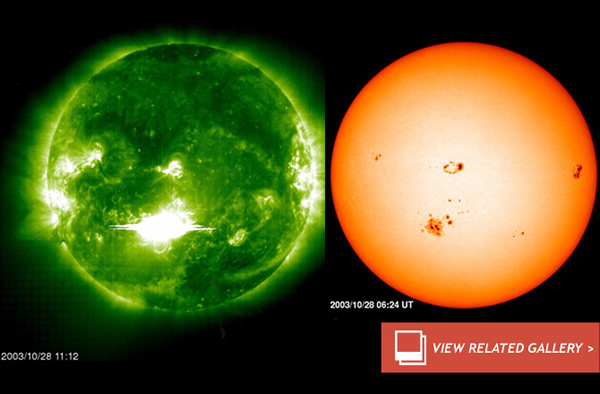The (Not So) Great Halloween Solar Storm of 2013
This is the year of the sun’s peak in its solar cycle. As expected, our nearest star is kicking off some pretty powerful flares and generating some nice auroral displays at high latitudes where energetic particles from the solar wind interact with the upper atmosphere. But this uptick in solar activity is nothing — nothing! — compared to the Great Halloween Storms of 2003.
I remember it now… [cue dreamy flashback scene] …a decade ago I was lucky enough to be working in the Solar Physics Group at Aberystwyth University, Wales, modeling coronal loops and the solar wind. Although my PhD was focused on theoretical studies of the sun’s magnetic lower atmosphere, I had more than a passing interest in what my office mates were working on.
As I arrived at my desk that autumn morning(-ish), I was greeted by fellow PhD postgraduate researchers Mario Bisi and Richard Jones (from the heliosphere research team) excitedly pointing at an animation depicting observations from the joint NASA/ESA Solar and Heliospheric Observatory (SOHO). “Look!” said Mario, poking the monitor with his finger. “Watch this,” he persisted.
I won’t confirm or deny if I was hungover that morning, but I do remember feigning interest, wondering how long it was until the 11 o’clock morning coffee break (or whether I’d missed it all together). But, suddenly, I snapped out of my morning funk to see an animation of the sun do something quite dramatic — the screen lit up with a bright detonation right on the edge of the solar limb. It was later confirmed to be an X28 solar flare, the most powerful solar flare ever recorded by space-borne instrumentation.
Looking back, I often think how lucky I was to be working in solar physics research during the peak of the previous solar cycle, especially around the Halloween period of 2003.
In the run-up to the historic Nov. 4, 2003, event the sun had been popping off an intense series of powerful solar flares and coronal mass ejections (CMEs) from two large active regions that were buffeting Earth. The radiation environment around our planet was causing all kinds of trouble for modern society. Aircraft were being diverted from polar regions to avoid communications blackouts, there were power outages in some parts of Scandinavia and NASA reported a range of problems with their satellite fleet, “ranging from temporary shut-downs to permanent damage,” according to a NASA Science News release.
I remember attending solar meetings shortly after with renewed vigor and excitement. We were constantly warning others about the dangers space weather posed to orbiting satellites, now we had proof of the dangers and we were developing the means to predict the sun’s harshest temper tantrums.
This exciting period of intense solar activity was quickly dubbed the “Halloween Storms.” And for good reason. For the first time humanity had a ringside seat at an intense solar storm at Solar Cycle 23. It was the first time that we had sophisticated observatories in orbit that could track the “solar maximum” with high precision, giving us on the ground advanced warning of incoming CMEs.
Fast forward 10 years and we are right in the middle of the peak of this solar cycle (Solar Cycle 24). Although this solar max hasn’t disappointed, Earth has gotten off fairly easy, so far. The majority of large X-class flares have been pointing away from our planet and we’ve only had a few minor hits by weak CMEs. Also, we’re not seeing the same magnetic ferocity as 2003′s Halloween.
“This spate of activity is inconsequential when compared to the 2003 events,” said Joe Kunches, space weather forecaster working at NOAA’s Space Weather Prediction Center in Boulder, Colo. According to Kunches, this year’s geomagnetic storm indices an order of magnitude smaller.
But, like the surprise X28 flare that caused such excitement in my office in 2003, the sun may have some belated Halloween tricks up its sleeve over the coming months. This minor solar storm isn’t over quite yet.
Image: A flaring event from the Halloween Storm of 2003. Left: The hot multimillion degree lower corona of the sun plus flaring region that saturated the SOHO optics, right: The sun’s lower photosphere at the time of the flare, dark (sunspot) active regions prominent. Credit: NASA/ESA/SOHO(Oct 31, 2013 06:47 PM ET // by Ian O'Neill)












